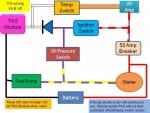Hello all, I’ll make a proper intro post when I have time and a running boat.
I have a 2008 Tahoe Q5i with the 4.3 TKS motor, SN 1A078281. Last weekend it left me dead in the water with no power to the ignition switch. Through research done here I found the TKS thermal switch and diode were both bad and had blown the 15 and 20 amp fuses in the circuit. TKS module tests fine on the bench. I have parts on the way...but they won’t be here until next week and the family really wants to get on the water this weekend.
I am thinking about leaving the temp switch unplugged and the diode out, and then running a stand-alone 12v circuit with a switch, relay, and fuse to the TKS module. Then just turn the switch on to energize the circuit and hold the plunger closed once the engine has warmed up. This would only be a temporary measure.
I can’t think of a reason why this wouldn’t work, but I thought I would run it by the big brains on here before I do more harm than good. Thanks for any input or suggestions!
- Flash
I have a 2008 Tahoe Q5i with the 4.3 TKS motor, SN 1A078281. Last weekend it left me dead in the water with no power to the ignition switch. Through research done here I found the TKS thermal switch and diode were both bad and had blown the 15 and 20 amp fuses in the circuit. TKS module tests fine on the bench. I have parts on the way...but they won’t be here until next week and the family really wants to get on the water this weekend.
I am thinking about leaving the temp switch unplugged and the diode out, and then running a stand-alone 12v circuit with a switch, relay, and fuse to the TKS module. Then just turn the switch on to energize the circuit and hold the plunger closed once the engine has warmed up. This would only be a temporary measure.
I can’t think of a reason why this wouldn’t work, but I thought I would run it by the big brains on here before I do more harm than good. Thanks for any input or suggestions!
- Flash




















